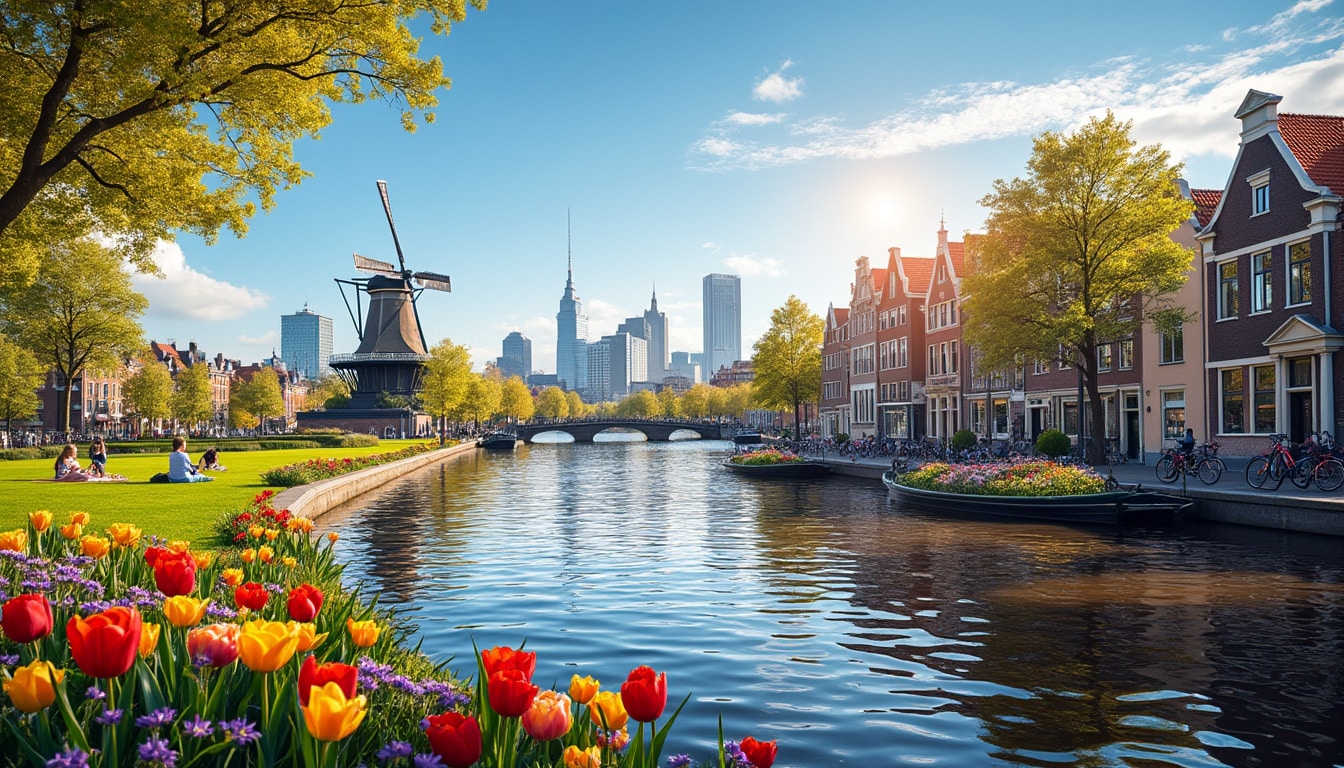Amsterdam, a city renowned for its iconic canals and liberal atmosphere, is as much a masterpiece of nature’s artistry as it is a marvel of human ingenuity. Cradled between the historic waterways and sprawling parks, the city’s landscape is a testament to innovation and ecological harmony. Discover how the unique geographic setting, characterized by below-sea-level districts and interconnected waterways, contributes to Amsterdam’s charm and resilience. Explore how urban sustainability blends seamlessly with nature’s pathways, creating a vibrant green hub that beckons locals and tourists alike. Journey through the canal collective, delve into the nature’s corner, and embrace bicycle bliss, while Amsterdam’s intriguing nature unfolds in every corner.
Geographic Wonders of Amsterdam
The heart of the Netherlands offers a dazzling array of geographic wonders, each contributing to the vibrant tapestry that makes Amsterdam an extraordinary city. From its inception, the city’s existence has been deeply intertwined with its natural surroundings. Located in the Dutch province of North Holland, Amsterdam’s unique positioning between the North Sea and the IJsselmeer lake ensures a marriage between urban life and water. This strategic placement not only facilitated trade but also fostered a culture characterized by openness and connectivity.
Amsterdam’s geographical marvels come to life notable with the prevalence of the Dutch Waterways. The city hosts a network of over 100 kilometers of canals, known as the Canal Collective, which have earned it the nickname “Venice of the North.” Built during the 17th century, these waterways are an integral part of everyday life, boasting not only historical significance but also an ingenious slant on urban adaptation. These canals, structured with the Herengracht, Keizersgracht, and Prinsengracht serving as prominent examples, display Amsterdam’s symbiotic relationship with its geography.
| Geographic Feature | Description | Significance |
|---|---|---|
| Canal Ring | A series of concentric canals | Facilitates trade, transportation, and tourism |
| IJsselmeer | Large shallow lake | Acts as a reservoir for fresh water systems |
| North Sea | Saltwater sea | Provides access to international trade routes |
The city’s landscape is accentuated by the Amsterdam Defence Line, a marvel originally constructed between 1883 and 1920. This strategic fortification, now a UNESCO World Heritage site, illustrates the city’s historical integration of military utility and natural terrain. Stretching 135 kilometers, this circle of defense ingeniously employed water as a defensive agent, harnessing the geography to ensure the city’s protection.
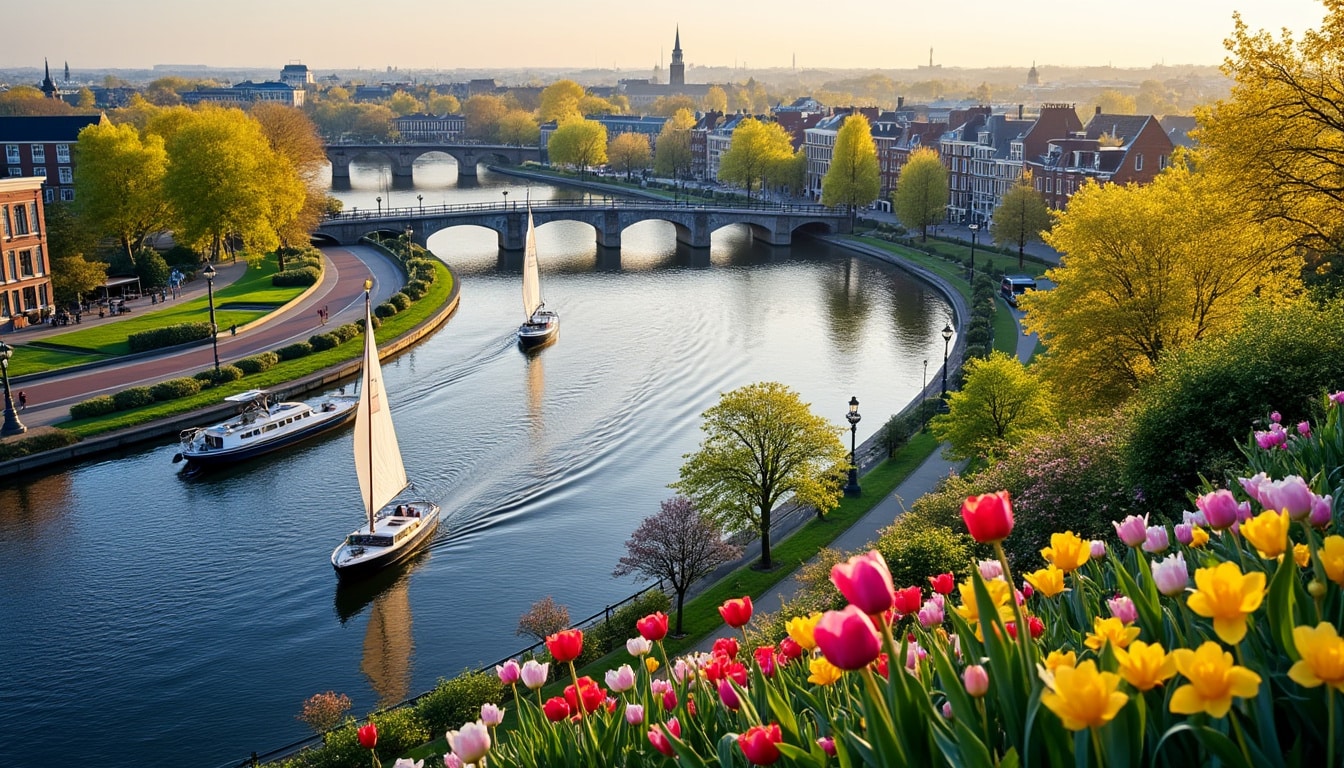
Eco-Friendly Amsterdam: A Modern Approach to Geography
Modern initiatives emphasize sustainability while embracing ecological treasures. Efforts to reclaim and utilize land cautiously, as seen with the contemporary IJburg district built on artificial islands, highlight innovation and progress. This blend of urban expansion and ecological mindfulness demonstrates Amsterdam’s commitment to evolving responsibly.
Amsterdam’s reliance on its geographic locale is also evidenced by its robust flood prevention measures. Large portions of the city fall below sea level, necessitating an extensive system of dykes and pumps to maintain safety from coastal and fluvial flooding. Such preparations are not only an engineering feat but also a testament to the city’s resilient relationship with its environment.
- 🌍 Strategic positioning between the North Sea and IJsselmeer
- 🛶 Historic Canal Collective weaving through the city
- 🏞️ Integration of urban and natural elements through the Amsterdam Defence Line
- 🚴 Embrace of sustainability with projects like IJburg
The Urban Greenery and Natural Pathways of Amsterdam
The tapestry of Amsterdam’s natural beauty is interwoven with its urban infrastructure, creating a unique harmony between development and nature. The city’s green spaces and pathways serve as vital lungs, supporting both ecological health and public well-being.
Amsterdam’s parks, such as the expansive Amsterdamse Bos and the centrally located Vondelpark, are pivotal to the city’s lifestyle. The Amsterdamse Bos, a sprawling 1,000-hectare forest, provides an oasis of tranquility amidst urban hustle. Within its lush confines, residents and visitors can explore a variety of recreational activities, from paddleboarding through serene waterways to meandering through densely wooded trails.
| Park | Location | Activities |
|---|---|---|
| Amsterdamse Bos | Southwest Amsterdam | Hiking, cycling, paddling |
| Vondelpark | Central Amsterdam | Theatre, leisure strolls, picnics |
| Beatrixpark | Amsterdam Zuid | Gardens, relaxation, dog walking |
At the heart of Amsterdam’s verdant network lies the concept of EcoCycle Amsterdam, where bike paths intersect with lush landscapes. The city’s commitment to bicycle-friendly infrastructure not only curbs vehicular emissions but also fosters a healthier, more cohesive community. As the city expands, the blending of urban plans with green corridors ensures that nature is never too far from reach.
Adding an extra layer to this green circuitry are the city’s nature reserves, like the Waterland area to the north—providing pristine wetlands that serve both as a haven for wildlife and a peaceful retreat for nature lovers. Strolling or cycling along designated paths allows for intimate interactions with Amsterdam’s diverse flora and fauna, illustrating the symbiotic relationship between urbanity and natural spaces.
Recreational Hubs and Nature’s Pathways
These recreational hubs not only prioritize environmental conservation but also act as communal spaces where citizens gather, celebrate, and connect with their surroundings. Initiatives in urban agriculture, rooftop gardens, and green rooftops enhance the ecological footprint by promoting sustainable agricultural practices and enhancing biodiversity.
The Dynamic Water Systems and Canals of Amsterdam
Immersed in a matrix of waterways, Amsterdam’s reputation as the “Venice of the North” is well-deserved. The city’s canal system, integral to its identity, exemplifies a blend of history, economy, and community connectivity. Preserved as a UNESCO World Heritage Site, these canals have undergone modernization to cater to contemporary needs while retaining their historic essence.
The canals are not solely appreciated for their scenic beauty; they play active roles in transportation, recreation, and ecological balance. Boat tours offer visitors interactive experiences, providing rich narratives of historical significance, such as the creation of the Canal Collective, and the architectural marvels lining their banks. The waterways serve as avenues for eco-friendly transport, with electric boats creating a silent and clean means to navigate this aqueous labyrinth.
- 🐾 Wildlife observation in canal riparian zones
- ⛵ Eco-conscious electric boat tours
- 📖 Storytelling experiences on Amsterdam’s history
- 🔄 Periodic water refreshment for ecological balance
The maintenance of these canals is a testament to Amsterdam’s dedication to sustainable urban planning. Employing natural techniques and innovative engineering, the city ensures these waterways remain clean and teem with life. The canals are periodically refreshed, facilitated by sluices and pumping stations, ensuring water purity and ecological vibrancy.
Canal Systems: A Living History and Future Vision
Beneath the surface, these canals hold a deep cultural and economic legacy. They once played host to merchant vessels during Amsterdam’s Golden Age, propelling the city to economic triumph. Today, they continue to be a crucial part of urban innovation, with visions for floating homes and shoreline restoration projects emphasizing the flexibility and dynamism of these living waterways.
Amsterdam’s Bicycle Bliss: Pioneering Urban Mobility
Amsterdam’s streets pulsate with the rhythm of cyclists, embodying the city’s devotion to a healthier and more eco-conscious way of life. Bicycle Bliss is a fitting term to describe Amsterdam, where two wheels consistently outpace four. The bike culture reflects both a respect for environmental sustainability and an enduring sense of community.
For those new to the city, cycling offers an intimate exploration of Amsterdam’s scenic routes and hidden treasures. Paths meander through historical quarters, across charming bridges, and into the heart of modern neighborhoods. Elements of the city’s architecture and canal systems become accessible in a way that integrates visitors and locals into Amsterdam’s dynamic flow.
| Pathway | Connects | Terrain |
|---|---|---|
| Nature’s Pathways | Parks and urban areas | Flat, scenic |
| Urban Greenery Route | City center to suburbs | Moderate with some inclines |
| Canal collective loop | Main canal ring | Flat, picturesque |
Plans continue to burgeon in Amsterdam to further promote eco-friendly travel. These efforts include expanding “Bicycle Highways” to nearby regions, creating seamless interconnectivity. Moreover, with initiatives like Nature’s Corner, where the countryside meets the city, Amsterdam constantly reinvents its commitment to biking infrastructure.
- 🚲 Enhanced bike lanes throughout the city
- 🛤️ Continued emphasis on Bicycle Bliss
- 🛣️ Expansion of regional “Bicycle Highways”
- 🅿️ Innovative parking solutions for cyclists
Biking is not just a mode of transport but a lifestyle, facilitating both individual freedom and communal connection. Its impact stretches far beyond the road, influencing social interactions and promoting a vibrant and cohesive city culture.
Creating a Cycling-Friendly Future
As the city envisages its future, Amsterdam’s investment in cycling continues to grow. From reduced carbon footprints to health benefits and reduced traffic congestion, the ripple effects of Amsterdam’s cycling love affair make it a model for other global cities striving for sustainability and community cohesion.
Frequently Asked Questions
- What is the significance of Amsterdam’s canal system?
Amsterdam’s canals are both a practical and historic marvel, providing transportation routes, supporting ecology, and contributing to the city’s identity as the “Venice of the North.” - How does Amsterdam balance urban development with nature?
Through projects like the Amsterdamse Bos, IJburg, and EcoCycle Amsterdam, the city integrates green spaces within urban settings to ensure sustainability and ecological health. - Why is cycling so popular in Amsterdam?
Cycling is an efficient, eco-friendly mode of transport that supports Amsterdam’s sustainability goals, making it easier for residents and tourists to navigate the city.
Amsterdam stands as a beacon of balance, merging historic allure with cutting-edge environmental stewardship. Its geography is more than a backdrop; it is a vibrant participant in the city’s life, offering endless opportunities for discovery and enjoyment.
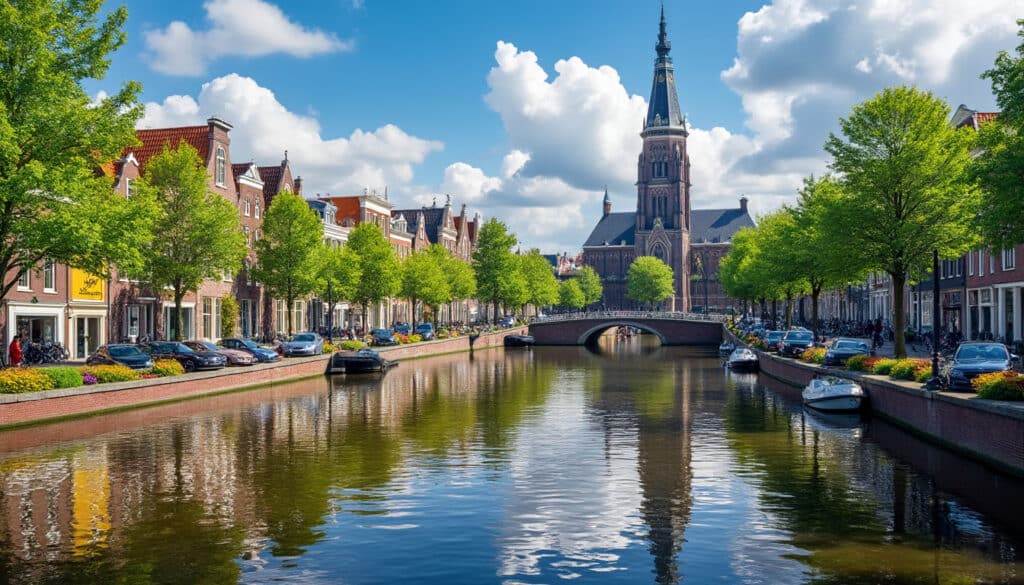
Geographical features of Amsterdam
Amsterdam, often called the “Venice of the North,” captivates its visitors with an intricate network of canals, lush parks, and architectural marvels. Known for its liberal culture and historical significance, this city stands at the crossroads of water and land.…
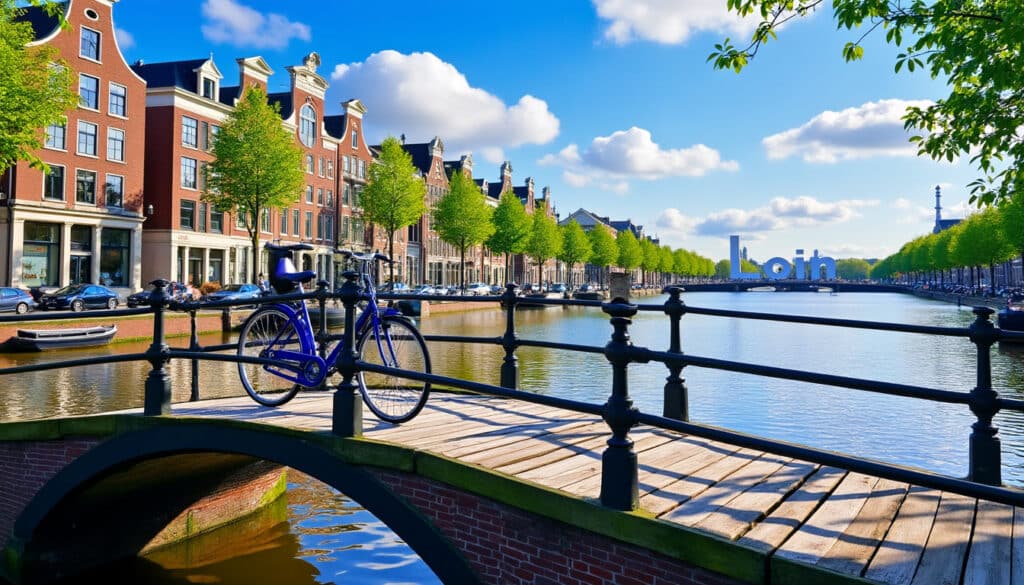
Location and coordinates of Amsterdam
Amsterdam, the vibrant and historical capital of the Netherlands, is a city that captures the imagination of anyone who has had the opportunity to wander its charming streets. Known for its iconic canals, rich history, and liberal culture, Amsterdam is…
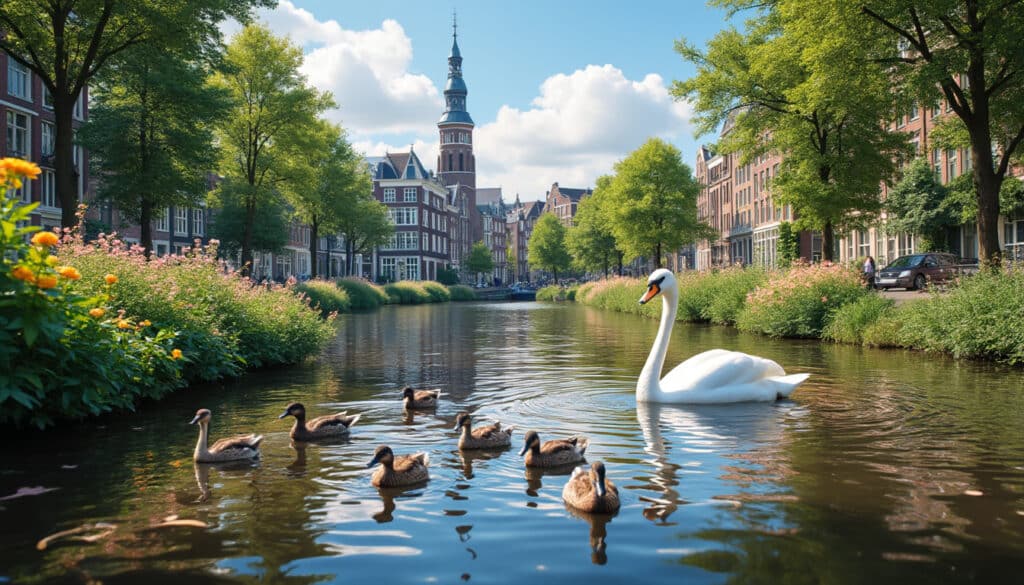
Nature and wildlife in Amsterdam
Amsterdam, often celebrated for its intricate canals and vibrant culture, stands as a sanctuary for nature enthusiasts and wildlife admirers. Though compact, the city surprises many with its extensive network of parks and green spaces, each uniquely contributing to the…
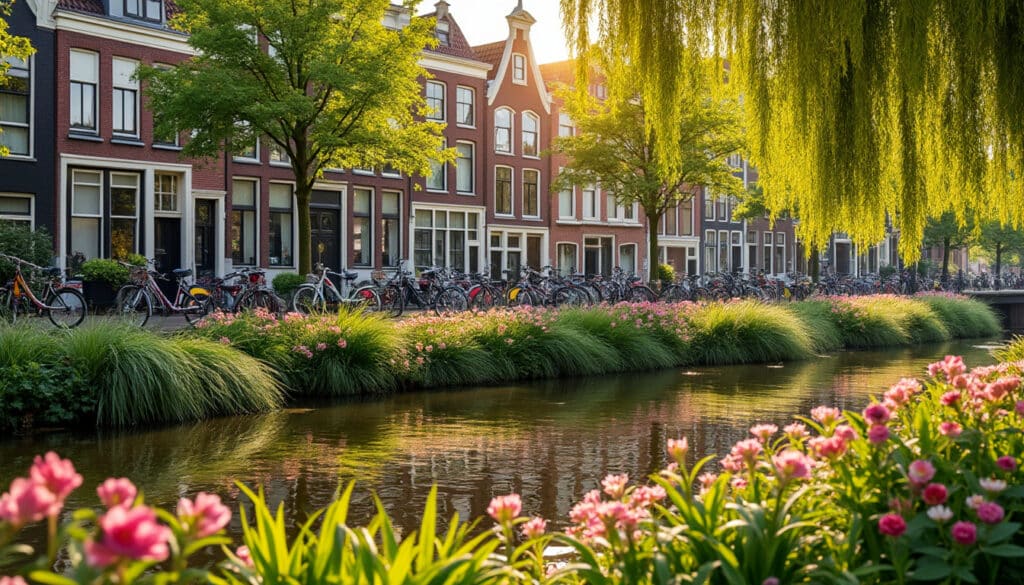
Rivers and water near Amsterdam
Amsterdam, a city famously intertwined with water, is not merely about its picturesque canals. It is a place where history, geography, and culture converge, revealing a unique relationship with several bodies of water that define its identity. From charming riverbanks…

